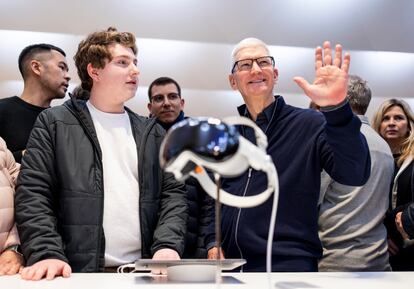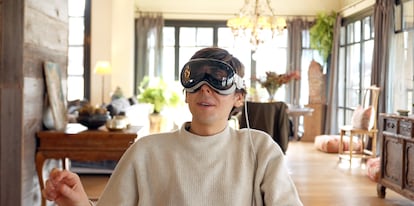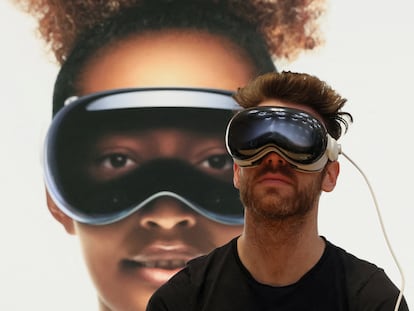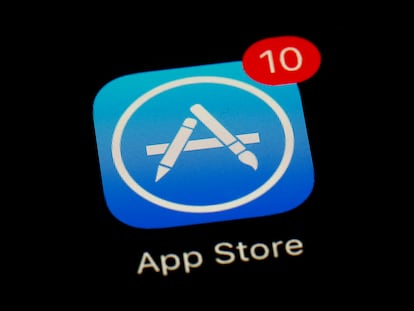Testing the Apple Vision Pro spatial computing headset
The pricey, bulky device offers little innovation and limited user autonomy


At Apple stores in the Washington, D.C. area, an appointment to test their Vision Pro headset (now available for purchase in the United States), is called an “invitation to a guided journey toward an extraordinary destination.” This destination, says Apple, is not the metaverse nor is it virtual reality — it’s spatial computing. Frankly, wearing the headset is a lot like experiencing life from the inside of an iPhone, iPad or Mac computer.
To test Apple’s latest product launch — the first in years — you need to schedule a 30-minute appointment with a specialist. In some stores, the wait can be several days. Adding to the suspense, the product won’t be available in Europe until some time in 2025 — exact date unknown.

Once the appointment is set, the first step is a facial recognition scan to measure your skull. This won’t be the last time a prospective customer (who might not even have the $3,500 to buy one) will have to hand over personal data for a chance to test Apple’s new product — there’s no free lunch, after all.
After a short wait, they bring you a Vision Pro that fits your head. It’s connected to an external battery pack with a two-hour life, similar to a wireless microphone transmitter. The headset obviously won’t work without it, so Apple helpfully suggests wearing something with pockets if you plan to use it outdoors.
Apple’s key innovation, compared to other headsets like Meta’s, is the ability to stay connected to the outside world while wearing it. The Vision Pro lets you be in two worlds at once. When you put it on, you see a home screen with all your apps, but you can also perceive the real world through the device’s 12 cameras and six microphones. This capability is the main reason the Vision Pro is so heavy and bulky. It weighs 21.2-22.9 ounces, (600-650 grams) and covers half your face. Having them on for several hours until the battery dies will probably be uncomfortable, especially on a scorching summer day. On the positive side, the Vision Pro showcases Apple’s customary sleek design, a nice cover to protect the screen, and a soft, spongy headband for comfort.
Three main buttons: one for taking photos and videos, a wheel to adjust the headband, and one called the “digital crown” for powering on/off, volume up/down, and back to home. Everything else is controlled visually. To open a photo, focus your eyes on it and pinch it with your thumb and index finger (no gloves required).
The Vision Pro test is designed to highlight its strength — the audiovisual experience. A panoramic view immerses you in a dramatic Icelandic landscape that you can view in 3D from various angles. The Vision Pro can play videos taken with iPhone 15 Pro — Apple’s most advanced smartphone — which they recommend having to maximize the headset’s potential. A sample video clip features a child blowing out birthday candles, prompting you to ponder how technology may enable you to relive memories of a departed loved one.
Nuevas gafas de Apple. ¿Nos extinguimos como especie? pic.twitter.com/4kHtbMXvdH
— Rafa Rodrigo 🏳️🌈 (@RafaRodrigoZ) February 5, 2024
The Vision Pro is great for tasks like writing (a wireless keyboard is recommended), browsing the web, and reading a news feed. It allows multitasking with multiple windows open, and you can watch movies (especially 3D ones), as long as they’re under two hours. Apple has blocked pornographic content on the Vision Pro with a technological “chastity belt.” Customers can view demos like a Super Mario Bros. trailer, and an immersive montage that allows the viewer to swim with sharks, walk a tightrope, and watch a goal by an Inter Miami soccer player (Leonel Messi’s team and Apple’s exclusive partner).
Once the test is over, the salesperson gushes, “Isn’t it amazing?” Indeed it is, albeit somewhat impractical. Since Netflix and Max haven’t released apps for the Vision Pro, you can only view the Apple TV and Disney+ catalogs for now. The availability of 3D movies is also somewhat limited. Apple says there are roughly 600 apps (including audiovisual content) for the Vision Pro. Official sales figures for the first few weeks after launch haven’t been released, but estimates indicate that around 200,000 units were sold.
Fresh meat for memes
Since CEO Tim Cook launched the Vision Pro at Apple’s Fifth Avenue store in New York City, early adopters of the headset in the U.S. have attracted a lot of social and news media attention. Transportation Secretary Pete Buttigieg even tweeted a warning about using the headset in autonomous vehicles after a viral video showed someone in a Tesla Cybertruck doing everything with their hands except keeping them on the steering wheel. Early adopters risk turning into memes of people using the headset as ski goggles, or waving their hands around like Tom Cruise in Minority Report.
Reminder—ALL advanced driver assistance systems available today require the human driver to be in control and fully engaged in the driving task at all times. pic.twitter.com/OpPy36mOgC
— Secretary Pete Buttigieg (@SecretaryPete) February 5, 2024
Nikias Molina finds it funny that his subway adventures with the headset in New York City have become so popular. The 25-year-old content creator from Barcelona who reviews Apple products on YouTube went to New York City to buy his Vision Pro on launch day.
“You know, I think they’re meant to be used while sitting down at home,” he said after two weeks of trying out the headset. “When I wore it around New York, and on the plane back, people asked me lots of questions. It was fun to see how they looked at me, because a lot of people don’t know that you can see out.” Molina likes the entertainment capabilities, and said, “it’s the best way to watch a movie, even though you’re all alone.” He also complimented the productivity aspects — “it’s like carrying your whole office around... The price is high and they could be lighter, but I think the technology is revolutionary; it’s like looking into the future.”

Molina says impatient Apple fans in Europe have fueled a thriving secondary market on platforms like eBay, where Americans who bought the headset are already reselling the pricey product. Prospective buyers on both sides of the Atlantic should know that the base price doesn’t cover all the necessary components for a complete experience. You’ll pay extra for the lens cover, additional storage, wireless headphones and other accessories. With all the bells and whistles, the Vision Pro costs over $4,600. That’s a stiff reality check for most consumers.
Sign up for our weekly newsletter to get more English-language news coverage from EL PAÍS USA Edition
Tu suscripción se está usando en otro dispositivo
¿Quieres añadir otro usuario a tu suscripción?
Si continúas leyendo en este dispositivo, no se podrá leer en el otro.
FlechaTu suscripción se está usando en otro dispositivo y solo puedes acceder a EL PAÍS desde un dispositivo a la vez.
Si quieres compartir tu cuenta, cambia tu suscripción a la modalidad Premium, así podrás añadir otro usuario. Cada uno accederá con su propia cuenta de email, lo que os permitirá personalizar vuestra experiencia en EL PAÍS.
¿Tienes una suscripción de empresa? Accede aquí para contratar más cuentas.
En el caso de no saber quién está usando tu cuenta, te recomendamos cambiar tu contraseña aquí.
Si decides continuar compartiendo tu cuenta, este mensaje se mostrará en tu dispositivo y en el de la otra persona que está usando tu cuenta de forma indefinida, afectando a tu experiencia de lectura. Puedes consultar aquí los términos y condiciones de la suscripción digital.
More information
Archived In
Últimas noticias
Mustafa Suleyman: ‘Controlling AI is the challenge of our time’
Venezuela breaks energy agreements with Trinidad and Tobago due to alleged complicity with the US
The murder of Michele and Rob Reiner: A tale of horrific days in Hollywood
Trump orders a ‘complete blockade of sanctioned oil tankers’ going to and from Venezuela
Most viewed
- ‘El Limones’ and the growing union disguise of Mexican organized crime
- Christian Louboutin: ‘Young people don’t want to be like their parents. And if their parents wear sneakers, they’re going to look for something else’
- ‘We are dying’: Cuba sinks into a health crisis amid medicine shortages and misdiagnosis
- A mountaineer, accused of manslaughter for the death of his partner during a climb: He silenced his phone and refused a helicopter rescue
- The low-cost creative revolution: How technology is making art accessible to everyone










































